Order Hymenoptera, Apoidea
- This page contains pictures and information about Mud-Daubers and Sand Wasps
that we found in the Brisbane area, Queensland, Australia. They are also known
as Sphecid Wasps and Apoid Wasps.
-
 -
- Species in these two families, Sphecidae and Crabronidae, are solitary hunting wasps. Female wasp makes nest in soil or
build mud cells for her young. She paralyses host arthropod, usually other
insects or spiders, by her sting. The sting is a modified ovipositor
which injects venom paralyses but not kill the host. She keep the hosts in the
nest and lay egg on hosts body. Larva hatches and feeds externally on prey.
Larvae are legless and grub-like. See our Panda Sand
Wasp page in which we had the detail information.
-
-



-
- Adult wasps feed on nectar or honeydew.
-
- Wasps in these two families are from small to large in size and some species have long slender waist. Adult wasps feed on
nectar or honeydew. All wasps in this family will sting, although most
Australian species are not aggressive. They
usually found hunting on ground or on leaves, or sometimes found dragging prey
to their nest. Nests are different for different species. Some nests are made by
burrowing in the ground, by using existing cavities in ground, in dead wood
or in pith of plants. Some species construct mud cells in open, on
house walls or rocks or tree trunks, some use abandoned mud nests.
-
- The
classifications of Sphecidae and Crabronidae are very confusing. Sphecidae and Crabronidae
were in one family Sphecidae and was the single family under former Superfamily
Sphecoidea. As now most recognised,
the former Sphecidae is
divided into two families, Sphecidae and
Crabronidae. The redefined Sphecidae
family constitutes only the subfamily Sphecinae. The Crabronidae constitutes
the rest of the former Sphecidae subfamilies. The Sphecoidea and Apoidea are closely related and
lately they are combined in one Superfamily
Apoidea. Sphecidae
and Crabronidae wasp species are differ from other bees in Apoidea in lacking branched hairs and broad, flattened hind legs.
-
- Wasps in this group usually have two spurs on hind tibia. Pronotum more or
less attached freely with mesothorax. Antennae usually 12 segmented in
female and 10 segmented in male. Females often with specialised structures
for digging.
-
- We found quite a number of wasps in Sphecidae and Crabronidae and listed in the following
pages;
-
- Sceliphroninae - Mud-dauber Wasps
- Wasps in
Sceliphroninae build mud cell nest and provisioned the young with spiders. They
have very long and slender petioles. They are the true mud-dauber, building
their nest with moist clay in hollow tree-trunks, sheltered part of rocks or
on walls of houses.
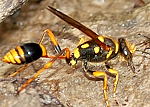

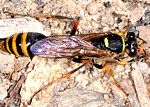 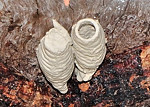
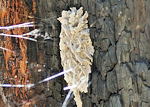
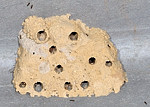 -
- Ammophilinae
- Thread-waisted Wasps
- The wasps in Ammophylini
are usually black/red or black/yellow in colours. They build ground burrows and provision with
caterpillars.
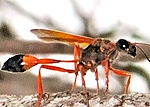 -
- Sphecinae - Thread-waisted Wasps
and Mud-daubers
- Wasps in subfamily Sphecinae are usually black in colour, from medium to large
size. They have the abdomen link with thorax with very slender cylindrical
stalk-like petiole. They predatory on Orthoptera,
including grasshoppers and katydids.
Females build nest for their young by digging long tunnel in sandy
ground.
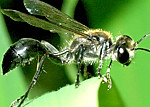 
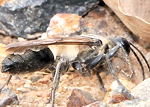
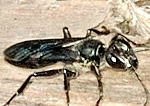

- Crabroninae (Larrinae) - Sand-loving Wasps
- Wasps in this subfamily Crabroninae are medium to large in size, with long body and
usually black (and orange), more elongate than Bembicinae.
They have spiny-legged and frequently with deformed ocelli. They generally provision with
Orthoptera. Some species
provision with spiders.
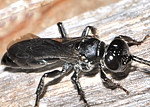
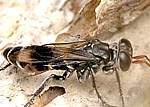
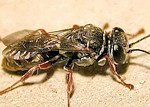
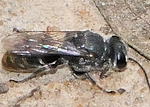
 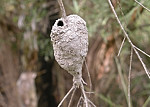 -
- Bembicinae (Nyssoninae) - Sand Wasps
- Sand Wasps in this subfamily Bembicinae are medium to large in size. They are ground
nesters. Females dig long barrow in sandy ground as nest for the young. They provision their nest with different insect
prey, mostly flies.
 
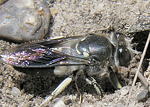 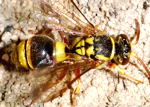
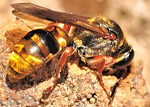 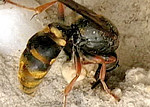 -
- Philanthinae - Social Digger Wasps
- Digger Wasps in subfamily Philanthinae are medium in size. They are black with orange-yellow
bandings. There is the petiole segment between the
thorax and abdomen.
The abdomen is constricted between segments. The head is relatively large and wide.
Those Digger wasps nest in bare, firm ground. They nest communally and there is
some division of labour.
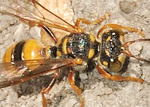

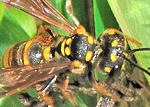 -
-
- Reference:
- 1. Insects
of Australia, CSIRO, Division of Entomology, Melbourne University
Press, 2nd Edition 1991, pp 989.
- 2. Insects of Australia and New Zealand - R. J. Tillyard, Angus
& Robertson, Ltd, Sydney, 1926, p297.
- 3. Family SPHECIDAE Mud-daubers, Sand
Wasps - Australian Faunal Directory, Australian Biological Resources
Study, 2009.
- 4. What wasp is that? - An interactive identification guide to the Australasian families of Hymenoptera, 2007.
- 5. Sphecidae - Insects of Townsville, Australia - Graeme Cocks.
- 6. Wasps - family Sphecidae - lifeunseen.com, by Nick Monaghan.
- 7. The sand wasps: natural history and behavior
- Howard Ensign Evans, Kevin M. O'Neill, 2007.
- 8. Northern Territory Insects, A Comprehensive Guide CD - Graham Brown, 2009.
- 9. Sphecidae - Australian National Insect Collection Database, CSIRO.
- 10. Family SPHECIDAE (Digger Wasps)
- Insects of Cedar Creek, Ecosystem Science Reserve, 2000.
- 11. Sphecidae {family} - Barcode of Life Database.
[ Nesting Behaviour ] [ Sphecidae ] [ Crabronidae ] [ Unknown Sphecid Wasps ]
|